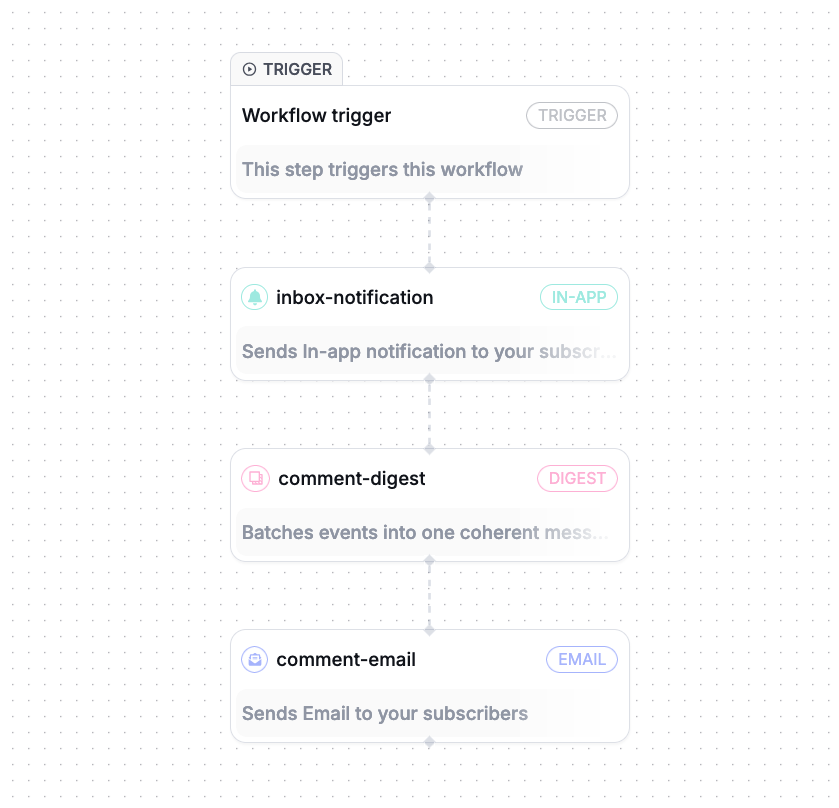Structure
A workflow acts as the blueprint for the notifications that will be sent. This is where all the different channels, filters, rules and actions are tied together under a single entity. The Workflow Editor simplifies building automated, personalized workflows without coding while also allowing developers to refine code-based workflows.How it works
Workflow Editor builds on the principle of steps. Instead of defining a single, complex piece of business logic, workflows contain multiple individual steps. In case of an error, a failed step is retried individually without needing to re-run any previous steps. Instead of the entire business logic, each step can take up your serverless function execution duration, and many more benefits. Here is how a workflow looks like in the UI Workflow Editor:
Here is how a workflow looks like in the UI Workflow Editor:

Workflow building blocks
Every Novu workflow is built using these four key elements:- Workflow identifier: A unique ID used to link triggers to the correct workflow
- Trigger: The event or action that starts the workflow
- Channel steps: These send notifications through your configured channels
- Action steps: Functions that manage the workflow’s logic and control its flow
Workflow identifier
Give your Workflow a clear, descriptive name that your team can easily identify. Workflow identifiers should be unique to your application and descriptive of the workflow’s purpose. For example:- Abandoned cart recovery
- Password reset flow
- New user welcome series
- Re-engagement campaign
Trigger
A trigger starts every workflow. It’s an action or event that tells the workflow to begin. To do this, you call the Novu API with a unique workflow trigger identifier (workflow_id), which links the trigger to the correct workflow.
When the trigger happens, it sends the data the workflow needs to notify subscribers. Learn more about subscribers.
Triggers are the only way to start workflows and send notifications, making sure everything runs as expected.
Example of a trigger
Here’s an example of an API call to trigger an event:
Channel step
A Channel step in Novu represents a configured provider to send notifications to your recipients. The Workflow Editor is designed for Omni-Channel Communication, delivering a unified experience across diverse messaging channels:- In-app notifications
- SMS
- Push
- Mobile push
- Web push
- Chat
- Enterprise messaging platforms (e.g., Slack, Microsoft Teams)
- Consumer messaging apps (e.g., WhatsApp, Telegram, Discord)
Action steps
Action steps are purpose built functions that help manage the workflow flow. Action Steps can be executed before and after Channel steps. For example, you can use a Delay to pause a workflow for a certain duration before sending a notification. There are three types of action steps supported by Novu:Example use cases
Order or transaction updates
Notifications for orders, shipping, or subscription statuses
User onboarding
Welcome emails, follow-up emails, and more
User engagement
Re-engagement campaigns, follow-up emails, and more
Product updates
Notifications for product updates, new features, and more
Abandoned cart recovery
Notifications for abandoned carts and follow-up emails
Password reset
Notifications for password resets and follow-up emails
Administrative actions
Notifications for administrative actions like account deletions and more
System errors and alerts
Notifications for system errors and alerts
Execution of workflow steps
When a workflow is triggered, its steps are executed in a predetermined sequence. This ensures a controlled, orderly flow and helps maintain the integrity of the notification process. Here’s how it works:1
Step-by-step activation
Each step is executed one at a time, in the exact order they are defined. This guarantees that dependencies and prerequisites for later steps are met before moving forward.
2
Predictable flow
Sequential execution creates a reliable process, ensuring that outputs from earlier steps seamlessly influence subsequent steps.
3
Orderly messaging
Messages are sent in a structured manner, preventing overlap or confusion and ensuring each step receives the attention it requires.

